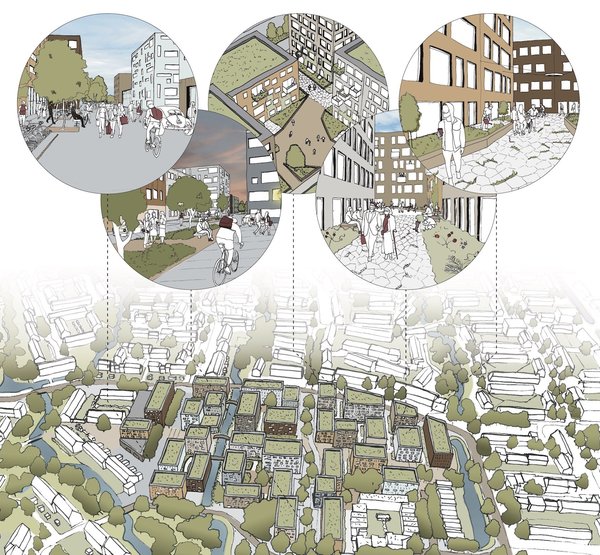New life in the ‘cauliflower neighbourhood’
Connecting the city to the university was a primary aim of an urban design student project in Tanthof, a neighbourhood in Delft.
Tanthof is a so-called ‘cauliflower neighbourhood’: a maze of winding streets and lots of low-rise buildings, explains Frank van der Hoeven, Associate Professor of Urban Design. In the 1970s, ‘cauliflower neighbourhoods’ were a response to neighbourhoods with impersonal blocks of flats arranged in a grid-like fashion, such as Voorhof and Buitenhof. Neighbourhoods needed to become more small-scale, dominated by green, low-traffic areas full of children playing.
Van der Hoeven says that Tanthof always scored high on resident satisfaction, but no longer. That is why the municipality believes it is time to think about improvements. Some of the challenges that lie ahead include:
- Tanthof is separated from the rest of Delft by the Kruithuisweg and is split into a western and eastern part.
- In both parts, a school is being closed down due to falling student numbers.
- The flow of residents has stalled: children have flown the coop, parents have paid off their mortgages and find new homes elsewhere too expensive.
- Today, the low-traffic areas are dominated by car parks.
- Delft needs to build 15,000 new houses across the city.
There is no shortage of work for urban designers, who once characterised ‘cauliflower neighbourhoods’ as ‘modern-day drab’. Wrongly so, believes Van der Hoeven. A view shared by Anna Myllymäki, one of the 75 students who visited Tanthof last autumn to develop ideas.
Myllymäki focused on security. ‘There was a lot of burglary and vandalism. Perhaps people no longer feel at home there’. She combined this with climate adaptation: creating a larger water surface to catch heavy rainfall. She transformed existing ditches and the numerous grass lawns into areas of water, creating little islands. ‘This clearly defines your area, your territory’.

Image: Rebecca Smink
For the old school in the east of Tanthof, student Rebecca Smink developed a plan for small houses with green roofs, which collect water and provide cooling. This creates a broader range of houses, for example to cater to parents with paid-off mortgages living in large family homes. Jian Yuan developed an algorithm that optimises walking routes and designed miniparks with long sitting benches as a new approach to low-traffic areas. The municipality presented dozens of plans. ‘Lecturers selected the plans based on ideas, not on grades’, says Van der Hoeven. The city therefore helps lecturers to take a different perspective and the university helps the city by introducing good ideas.